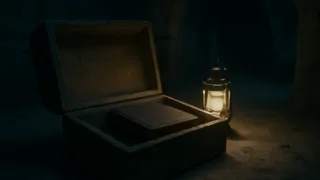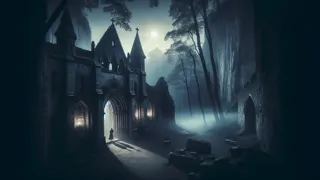Introduction
In the remote hills of Northumberland, the ruins of St. Michael’s Abbey hold more than silent arches and weathered stones. Under the silver gaze of a moon drifting behind restless clouds, each crumbling buttress, moss-covered gargoyle, and shattered stained-glass fragment seems to murmur secrets of a time long past. Rumor has it that centuries ago, Abbot Thomas, a man of both quiet piety and adventurous spirit, stumbled upon a hidden cache of treasure deep within the abbey’s subterranean vaults. Some say he was driven by greed, others claim he hoped to preserve relics from the dissolution of the monasteries. On the night before his final sermon, he vanished without a trace, leaving behind only cryptic inscriptions and a faint, otherworldly glow that flickers beneath the oldest tombstones. Locals speak of ghostly lantern light weaving through the nave and footsteps echoing down deserted cloisters. Drawn by equal measures of skepticism and wonder, Eliza, a historian with a passion for uncovering lost legacies, and Owen, a meticulous mapmaker skilled in deciphering medieval cipher, step into St. Michael’s threshold. Their lamps sway in the damp air as they cross the marble floor, each breath heavy with anticipation. The wind, chill and unforgiving, stirs the dust-laden air and carries with it the faint toll of a distant bell that seems to chime from beyond mortal reach. Vines, thick as braided ropes, weave through broken gates as though determined to keep intruders at bay, yet with every echoing footfall, time itself seems to pulse around them—alive and restless.
Whispers in the Abbey
As Eliza and Owen moved deeper into the nave, the air grew colder and the wind’s sigh became a chorus of hushed voices. Each footstep upon the flagstone floor rang out like a challenge, and candlelight danced across ornate carvings depicting saints and warriors long forgotten. Eliza knelt beside a broken lectern to examine an inscription etched in Norman script. Owen, peering over her shoulder, traced its characters with gloved fingers. The words, once clear, had faded under layers of dust, but their meaning remained: “Where faith meets fear, the path reveals itself.” They traded a curious glance and pressed onward toward the cloisters, where statues of hooded monks stood vigil amid tendrils of ivy. The wet stones glimmered beneath their lanterns, reflecting ghostly shapes that teased the corner of the eye. A faint draft carried the soft rustle of parchment in the distance, and with steady breath, Owen followed the sound through a hidden arch. Behind a fallen pillar, they found a fragment of vellum pinned under rubble: a sketched map hinting at concealed stairways and buried vaults. The edges were charred, as though purposefully singed, and each line pulsed with promise and peril.

Eliza unfolded the parchment with great care, revealing a labyrinthine blueprint of subterranean chambers beneath the altar. Symbols marking crosses, chalices, and coded runes hinted at traps laid centuries earlier to deter the greedy. “Abbot Thomas,” she whispered, “built more than an abbey—he constructed a testament to doctrine and secrecy.” Owen’s eyes glittered in the half-light. “We must tread carefully; every step might trigger a mechanism.” The weight of their discovery pressed on them, and the abbey seemed to respond. Overhead, a sudden gust rattled broken rafters, sending a cascade of dust that drifted like ghostly snow. In that moment, the corridor grew silent, as if listening to their resolve.
Gathering their courage, Eliza and Owen lit a second lantern and descended a narrow stone staircase tucked behind a drift of fallen masonry. Each step echoed in the cavernous gloom, drawing them toward a grand crypt sealed by iron-bound doors. Carved into the lintel was a verse, half-hidden by moss: “Only those who heed the living words shall claim what lies below.” Eliza’s heart pounded with both excitement and dread as she traced the phrase with trembling fingers. Owen pressed his ear to the door, and the faintest echo—two quick raps—answered his patient vigil. Together, they steeled themselves and pushed the doors inward, stepping into darkness that promised both fortune and fate.
Nightfall and the Hidden Map
Silence enveloped the crypt beyond the iron doors, broken only by the soft drip of condensation from the vaulted ceiling. Owen raised his lantern to reveal rows of carved sarcophagi, their lids worn by time and the weight of history. Each tomb bore a name—but none bore the seal of Abbot Thomas. Instead, at the far end, a recess held a stone chest engraved with quartered shields and Latin phrases. Eliza approached with reverent caution, her every sense alert to hidden dangers. She sensed the air shift, as though the crypt had awakened at their intrusion. Owen knelt to inspect the lid and found hinges that bore the insignia of a warding spirit; the metalwork was cold to the touch, yet strangely warm pulses seemed to hum beneath its surface. With careful hands, he lifted the lid only to reveal a leather-bound codex wrapped in crimson cloth. The pages crackled with age and flickered under lantern light, revealing colors still vivid despite centuries underground.

The codex bore clues both visual and verbal: a series of illuminated drawings depicting the abbey’s architecture intertwined with cryptic verses. A syllable-based cipher disguised references to hidden shafts and false floors. Eliza recognized the style as that of a scriptorium master who served during Abbot Thomas’s tenure. “He mistrusted outsiders,” she murmured. “This codex was his voice, his final defense.” Owen’s brow furrowed as he studied a ringed diagram showing a sunburst motif aligned with the winter solstice sunrise. “If we wait until dawn,” he said, “the first light will reveal a concealed hatch in the cloister’s eastern arcade.” The prospect of timed discovery thrilled them both, but Eliza hesitated. “One misstep could seal our fate.”
Night deepened as they retraced their path, the codex pressed against Eliza’s chest like a heartbeat in paper form. Outside, the abbey courtyard lay in moonlit stillness, sculptures of saints draped in ivy just visible through shattered windows. They paused beneath an arched portal where, according to the map, a hidden lever disguised as a gargoyle’s jaw would unlock a secret passage. Owen reached up and pressed his thumb into a carved indentation; a low rumble reverberated through the stone, and a section of floor slid aside, revealing a narrow shaft descending into pitch black. The wind howled through the chamber, carrying with it a distant chant that rose and fell like a lament.
In that charged moment, Eliza and Owen exchanged a solemn nod before descending into the unknown. Their lanterns bobbed like fireflies against the vast darkness, and each breath felt heavy with the tension of an unseen presence. The hidden shaft led to a long corridor lined with faintly glowing sigils, guiding them deeper still. With each step, the thrill of discovery warred with the fear of what they might awaken. Yet both knew there was no turning back: Abbot Thomas’s legacy lay ahead, buried beneath layers of stone and sorrow.
The Crypt and the Ghostly Guardian
The narrow corridor opened into a vast chamber lit by a pale shaft of moonlight that filtered through a circular oculus high above. At its center stood an ornate altar carved from black marble, atop which lay a bronze reliquary engraved with symbols both sacred and arcane. Eliza inhaled sharply; years of study had prepared her for this moment, yet nothing had primed her for the hush that followed. The chamber’s walls were lined with mosaics of monks in prayer, their faces turned toward the reliquary as though awaiting a divine command. Shadowy forms flickered at the edge of the light—shapes that shifted, dissolved, then rematerialized like figures woven from mist.

A voice, soft yet resonant, spoke in Latin and English in turn: “Guardianship is the final vow of the departed.” From the gloom stepped a figure robed in monastic habit, its face hidden beneath a cowl. Eliza and Owen froze, lantern beams trembled in their hands, and the ghostly presence drifted toward them. Wisps of candlelight seemed to cling to its fingertips as it lifted a skeletal hand, beckoning with solemn grace. Owen swallowed his fear and bowed his head briefly; Eliza’s heart raced, but she forced her stance to steady resolve. “Abbot Thomas?” she ventured. The apparition inclined his head, and a hush deeper than silence fell.
“I took an oath to protect the treasure I uncovered,” the ghost intoned. “I remain bound until one proves worthy by courage, wisdom, and compassion.” Eliza stepped forward, meeting the ghost’s hollow gaze. She spoke of her reverence for history, her promise to honor the abbey’s legacy, and her belief that relics belonged to those who cherished their stories. Owen described the dangers they had faced, the puzzles solved by trust and respect rather than greed. The ghost listened, the air seeming to pulse with each syllable. Finally, it raised its arms, and with a gesture, the reliquary’s lid slid open of its own accord.
Inside lay gilded chalices, coinage bearing royal seals, and a delicate manuscript bound in silver filigree. Eliza dared to touch the reliquary; its warmth spread through her fingers like a living heartbeat. A soft wind circled the chamber as the ghost faded, its final words carried on the breeze: “Your hearts have proven true. May this gift serve the living as much as the departed.” The moonlight dimmed, and the mosaics seemed to brighten with a shared serenity. Together, Eliza and Owen gathered the treasure, reverent in the glow of newfound hope. As they turned to leave, the hidden hatch sealed once more, and the abbey exhaled centuries of silence.
Conclusion
Exiting the abbey before dawn, Eliza and Owen carried more than gold and relics—they bore a renewed reverence for the fragile boundary between past and present. The ghostly guardian’s blessing echoed in their hearts as they crossed the dew-glazed courtyard, each footstep a testament to courage proven in darkness. News of their discovery would spark scholarly debate and ignite local legend once more, breathing life into St. Michael’s Abbey after centuries of silence. Though the treasure found new hands, its true value lay in memory and the stories that bind us across time. As they departed into the soft first light, Eliza pressed the silver-filigreed manuscript to her chest and offered a silent prayer: may Abbot Thomas finally rest, knowing his legacy endures in those who dared to listen to whispers in the abbey.


















